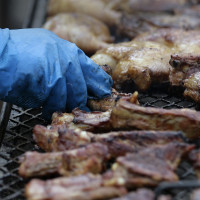
(CNN)Sweet ‘n’ sour pork. Lamb bhuna. Cheese quesadillas. Pasta con pomodoro.
Famous dishes from Asia, Europe and the Americas have all left their indelible mark on menus around the world.
African cuisines, however, have been slow to catch on globally.
In Uganda, for example, a dish called “the Rolex” — a rolled chapatti containing a fried egg and vegetables — is wildly popular, but little known outside the country.
“Rolex was started by a few university kids,” adds Jon Blanc, the director of Ugandan tour company
Kabiza Wilderness Safaris.
“Today all over Uganda men cook them on the street. In Rwanda where no street food is allowed, it is served in a few restaurants.”
Now, chefs from the African continent, and beyond, are trying to promote dishes from their home nations in very different ways online — and making a living from it.
Here’s how they are doing it — and, of course, what you should be eating.
Zimbio’s Kitchen (Zimbabwe)
Sadza served with mince and veg mix #zimbokitchen #iamzimbo #zimbabwefood #yum #sadza
A photo posted by Rumbie (@zimbokitchen) on May 19, 2016 at 1:13am PDT
Who: Charlene Shoko, 31
Key Zimbabwean dishes: Sadza, a thickened porridge served at most meals; Nhedzi, a wild mushroom soup; and Dovi, a traditional peanut butter stew.
How: Shoko’s blog zimbokitchen.com aims “to solve the daily pains of the Zimbabwean home chef, helping people prepare traditional Zimbabwean cuisine”.
“Google organic search has also enabled us to grow — any search on Zimbabwean food brings up ZimboKitchen in the top results,” Shoko adds.
Revenue streams: sales from themed recipe eBooks.
Why Zimbabwean food? It’s a custom to share dishes in Zimbabwean culture, and diners are encouraged to pace themselves and not to finish before the others.
Kaluhi’s Kitchen (Kenya)
How amazing does this ndengu look?! This recipe will be in my ebook which will be available to you guys TOMORROW at 6 p.m I have decided to stop waiting for the perfect moment and perfect everything and just do this. It will cost you just 527 ksh. More details tomorrow. Are you ready for this?! You should be! #InMyKitchen #MustHave
A photo posted by Kaluhi (@kaluhiskitchen) on May 16, 2016 at 7:55am PDT
Who: Kaluhi Adagala, 24
Key dishes: Ugali, a dense cornmeal paste; Irio, mashed green peas and potato; and Githeri, a corn and beans dish.
How: Based in Nairobi, Kenya, Adagala uses her blog to promote dishes with a heavy Kenyan influence.
“I take our beloved traditional recipes and reinvent them by adding … a much more global feel with ingredients that are locally available. My mission is to show the world Kenyan food and to put Kenyan food on the global culinary map.”
Revenue stream: brand partnerships, for example assisting with the marketing for Nairobi Food Market.
Why Kenyan food?
“Kenyan cuisine is an amalgamation of ethnic, Indian and Arabic cuisine which have been slightly modified over centuries to suit our needs.
“With 42 tribes in our country, food preparation and methods borrows heavily from one tribe to the next which makes Kenyan food a celebration of diversity.”
Taste of Tanzania (Tanzania)
Today's dinner mishikaki ya ng'ombe (beef kebab), cassava futari (futari ya muhogo) and amaranth greens (mchicha). Amaranth can be replaced with spinach. All these recipes in Taste of Tanzania cookbook.
A photo posted by Taste Of Tanzania (@tasteoftanzania) on Aug 5, 2013 at 7:15pm PDT
Who: Miriam Kinunda, 47
Key dishes: Ugali, a dense cornmeal paste; Nyama Choma, grilled meat; and chapati, a type of bread.
How: Kinunda’s Taste of Tanzania website, which she started off writing in Swahili, started gaining popularity in 2009.
Revenue stream: self-published books, YouTube channel and Taste of Tanzania spice brand.
Why Tanzanian food? “The Swahili people adapted to the cultures of the people that colonized them, from Persians, British, and Portuguese.
“You can find a few Swahili recipes that use the same names as some Persian or Indian recipes, but are prepared very differently.”
Eat Ethio (Ethiopia)
Desk lunch 'Habesha' style.
A photo posted by Eat Ethio (@eatethio) on Feb 16, 2016 at 7:12pm PST
Who: Helina Tesega, 35
Key dishes: Injera, a spongy flat bread; wat, a spicy meat or vegetable stew; and Kitfo, marinated minced beef.
How: Based in Hong Kong, Tesega is bringing dishes influenced by her mum’s Ethiopian home cooking to Asia.
“There is little understanding [in China] of Ethiopia, its rich history, the people, the food and the culture … I provide a modern insight into all of this in a credible way.”
Revenue stream: supper clubs and catering events.
Why Ethiopian food? “I honestly think Ethiopian food is one of the most flavorsome of cuisines. It’s so distinctive,” Tesega says.
Berbere and niter kibbeh are key to Ethiopian cooking: berbere is a very hot blend of spices made from a large red chilli. Niter Kibbeh is a seasoned, clarified butter used in all kinds of dishes from meat to vegetables and eggs.
Zoe’s Ghana Kitchen (Ghana)
Fried chicken, jollof rice, and plantain .
A photo posted by Zoe's Ghana Kitchen (@ghanakitchen) on May 18, 2016 at 8:31am PDT
Who: Zoe Adjonyoh, 38
Key dishes: Jollof rice, a one-pot spiced rice dish; fufu, dough-like dish made with cassava; and kelewele, fried seasoned plantains.
How: Born to a Ghanaian father and Irish mother,Adjonyoh started her business after spending time in her grandmother’s kitchen in Ghana, and visiting the famous Kaneshi street market in Accra.
Revenue stream: pop-up restaurants in London and Berlin, catering and cookbooks.
Why Ghanian food? There are some seriously cool venues to do so in. Adjonyoh’s latest venture is a restaurant in a shipping container community project
Pop Brixton, in South London.
Read more: http://www.cnn.com/2016/06/05/africa/african-food-internet/index.html













